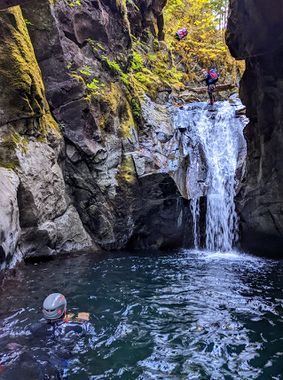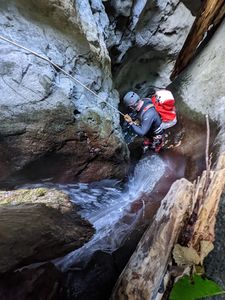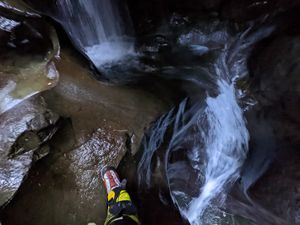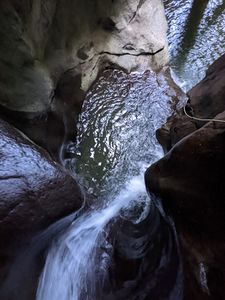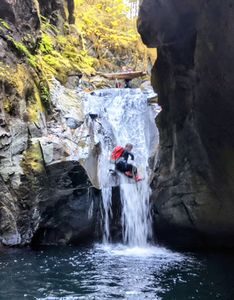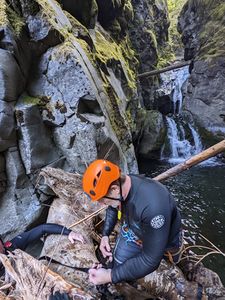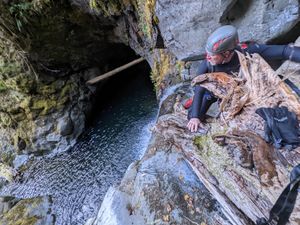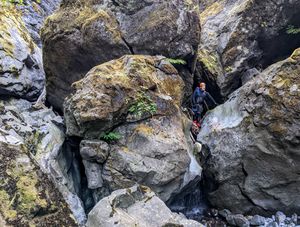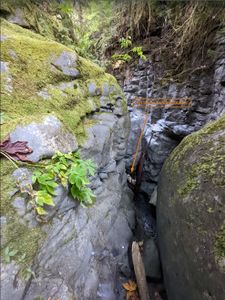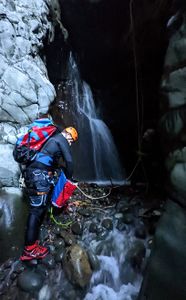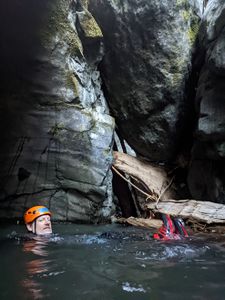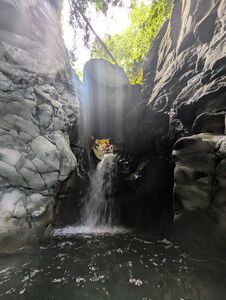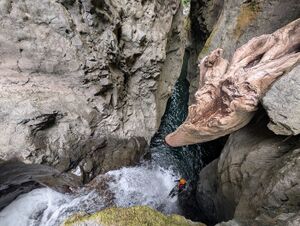Lower Fulton Creek
| Rating: | |||||||||||||||||||||||||||||||
|---|---|---|---|---|---|---|---|---|---|---|---|---|---|---|---|---|---|---|---|---|---|---|---|---|---|---|---|---|---|---|---|
| | Raps:7, max ↨40ft
Red Tape:No permit required Shuttle:None Vehicle:High Clearance | ||||||||||||||||||||||||||||||
| Start: | |||||||||||||||||||||||||||||||
| Parking: | |||||||||||||||||||||||||||||||
| Condition Reports: | 9 Oct 2025
"Flow similar to prior descent in late June. Exit path requires some attention as there are many game trails throughout. Requires careful navigation to |
||||||||||||||||||||||||||||||
| Best season: | Jul-Aug-Sep
|
||||||||||||||||||||||||||||||
| Regions: | |||||||||||||||||||||||||||||||
Introduction[edit]
This page describes the lower section of Fulton Creek. This is a committing section of the canyon with some fun rappels, deep pools, and interesting water features. Of particular note is a terrific waterslide mid-canyon into a deep punchbowl. Lower Fulton, on its own, is probably a half-day adventure.
- Upper Fulton Creek (aka Classic Fulton) is shorter separate section of the canyon and is described on its own page. It is possible to run both the upper and lower sections of this creek in a single trip, but expect a much longer day out. The middle section of the creek linking the two is described on the Upper Fulton page.
- Watershed: 8mi^2. Highest point in the watershed is East Rock at ~4270' elevation. Expect to see about twice as much water as Upper Fulton.
Approach[edit]
Just north of Triton Cove State Park, turn left off Hwy 101 onto Seamount Dr. Follow the road upwards ~0.9mi where the pavement ends. The road gets very rough after this point. High clearance recommended (maybe 4WD); use extreme caution with low-clearance 2WD vehicles. (2025: the road has deteriorated at this first section, so it's less of a recommendation and more of a requirement).
- Please do NOT park in the pullout at the end of the pavement. While technically legal, there are several homes very close by. Some canyon groups parking here and hiking/carpooling up the road has led to conflicts with the local residents. To avoid problems and keep them happy, it's recommended to park elsewhere (ex: Triton Cove State Park - Discovery Pass required) and carpool to Fulton in a high-clearance vehicle.
At the end of the pavement, continue up the rough dirt road for another 0.3mi to a pullout on the right with room for several vehicles.
Hiking In[edit]
From the pullout, walk up the road about five minutes and climb over a berm onto an old logging road. Make your way through an old clear cut and descend a ridge into the canyon. As you near the tree line, bear off to your right/north and cross a gully to the next ridge following a faint game trail. Drop down the far side to the entrance of Lower Fulton. R1 is a short walk downstream.
Descent[edit]
Technical Notes[edit]
- DCL = Down Canyon Left.
- DCR = Down Canyon Right.
- Please do not leave webbing on any anchors in the watercourse. Fulton flows big in the off-season and any webbing left in the watercourse gets completely trashed. Glance above you in the narrow canyon and you may notice the high water line is several feet over your head. A drill and bolt kit is recommended for the first team through each season.
- Giant logs have moved significantly from year-to-year, so do not rely on log anchors being present. Log jams have also been created and disappeared over the years. A small folding saw is recommended for the first team through each season.
- All jumps and slides should be scouted in advance to ensure the water is deep enough and there are no submerged obstacles. Jumping is a leading cause of canyon injury (i.e. broken ankles and legs).
- There are a number of short downclimbs that are not listed in the beta below.
- Beware running Lower Fulton early in the season as there are a number of siphons. A few of the obstacles encountered could be quite dangerous / difficult to overcome in high water. It may not be possible to escape the canyon until below R6.
Descent[edit]
- R1: Single bolt DCR on the giant chockstone. Rappel 35ft down a cool spiraling chute into a chamber/pool underneath the giant chockstone.
- J1: 5ft drop into pool from bottom of spiraling chute. The rope from R1 can be extended to scout the pool. It may be better to pull the rope for R1 from the top of the jump as the water is quite deep below.
- J2: Downclimb to a shallow jump (~3ft) into a small pool. Use caution as the pool is not deep. This likely will need to be a rappel in higher flow.
Make your way through a narrow low-angle trough into the next big pool. Beyond, there's a short walk to the next obstacle.
- S1: Amazing 35ft beautiful slide, with a 7ft vertical drop at the bottom into a very deep punchbowl. (There is no anchor here as the previous log anchor has washed downstream. Recommended practice would be to send first person down on a meat anchor to check the depth of the pool, meat anchor anyone else who wants to rappel, and have the last person/people send the slide assuming it remains deep.)
- Swim the pool below S1, then downclimb into the next pool. (This might be a rappel depending on water levels. Also possible shallow jump.)
A large logjam blocks the exit of the next pool. A partner assist may be helpful to climb out. The next rappel comes immediately.
- R2 or J3: Rappel 25ft from the logjam or jump 25ft to the pool below.
Just ahead, enter the giant boulder garden. The boulder garden was passable without any rappels in August 2024. Different groups may choose different scrambling route or elect to do rappels.
Continue downstream for a short distance. Bear DCR to reach:
- R4: 20ft down a ramp from a single bolt DCR.
- R5 or J4: 15ft rappel from large log creek-center 25ft back from the lip, requiring 40 ft of rope length. Please do not leave webbing here. Or jump 15ft to pool below (DCL of the whitewater was deepest in August 2024).
- R6: The Dragon's Den. This section has changed quite a bit since the FD. In 2025 you now rap through a large hole down into the "den", and exit by climbing over what used to be a swimming exit. On the FD there was no hole, but you could swim out through a tight gap to exit.
- R7 or J5 35ft from single bolt. Upon arriving at the top of the pitch, the creek diverts around both sides of yet another large boulder. Downclimb around the DCL side to find the bolt creek-center on the downstream side of the boulder, making a nice line down the drop. The rappel drops into a mini chest-deep pothole, then clamber out to rappel the rest of the way down. Or down climb to the mini pothole and jump 20ft to the deep pool below. Swim out through a short water-filled narrows. Other jump options exist, including a airy hop over to the tree and a jump from there.
Exit[edit]
Below the final rappel, the canyon abruptly opens out. There's a nice place DCL to change out of wetsuits.
- On the DCL/north side of the creek, a very nice, well-maintained trail heads off downstream. Do not go this direction! The path leads quickly onto private property. Plans are currently afoot to contact the local land owner regarding access. This page will be updated when new information becomes available. (With a good exit and car shuttle, Lower Fulton would be amazing.)
- Instead, exit the creek abruptly DCL, and make your way directly north, bushwhacking up a ridge. The distance is .3 miles and elevation gain back to the road is 430 feet, it is steep and unrelenting. Keep a northerly course to stay on timber company land.
Ascend the initial section of the exit route until you reach a relatively flat area. This section is slightly overgrown, but offers a clear view of the next climb. Press onward, finding the most direct route upward. A game trail is present in this area, which significantly eases the climb once located. The top of this ascent brings you to another flat area, marking the false summit. From here, the houses of neighboring residents will be visible, so be sure to keep left as you navigate toward the road. A final short but steep climb remains, with some brushy sections. While a trail has been cut, some areas with lighter brush may still require attention. The exit should take approximately 45-60 minutes to complete.
Upon intersecting Fulton Creek Road, walk back to your waiting vehicle (~2min). Declare victory.
Red tape[edit]
Be aware: Lower Fulton is on private timber company land. Access could be rescinded at any time, so please treat the area with respect and practice your best Leave No Trace.
Please stay on timber company land and do not follow the trail downstream upon exiting the canyon.
Beta sites[edit]
Trip reports and media[edit]
Background[edit]
Lower Fulton was first descended in Sept 2022 by Kevin Clark, Hereward Cooper, and Alex Danielson. We ran both Upper and Lower Fulton, exiting just before sunset.
In 2023, a second descent team: Kevin Clark, Clint Clow, Emily McEntire, Trey Schutrumpf, and Eric Rutz finished exploring the bottom of the creek and discovered the exit trail.
In 2024, explorers and trailblazers, Michael Schoenheit and Brian Wellman, cleaned up and published a new exit for future canyon expeditions.
